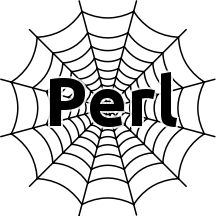WebPerl

Run Perl in the browser with WebPerl!
[ Using - Building - 🦋 - Notes - Legal - Wiki ]
Building WebPerl
Notice: WebPerl is very much in beta. Some things may not work yet, and parts of the API may still change. Your feedback is always appreciated!
This page documents the Perl 5 support, for the experimental Perl 6 support, see here.
Prerequisites
- Linux, a fairly modern release is strongly recommended, and
bash(tested on a minimum of Ubuntu 16.04) git(e.g. Ubuntu/Debian:sudo apt-get install git-core)- Build tools for
perl; for example on Ubuntu:sudo apt-get install build-essentialandsudo apt-get build-dep perl - Perl, at least v5.26 (for example via Perlbrew)
- Emscripten SDK, 1.38.10 and up, please see the prerequisites and installation instructions at http://kripken.github.io/emscripten-site/docs/getting_started/downloads.html#installation-instructions
- The build script has several CPAN dependencies. You can install these via
cpanmand the providedcpanfile:cdto thebuilddirectory, then runcpanm --installdeps .(Otherwise, see thecpanfileor the source ofbuild.pland install these modules with the installer of your choice. Another possibility is to uselazy, e.g.perl -Mlazy build.pl --help) - A working Internet connection is needed for installation and the first build.
Source Code
The source code is in two repositories:
-
https://github.com/haukex/webperl - the main WebPerl repository
-
https://github.com/haukex/emperl5 - a fork of the Perl 5 source repository where the WebPerl-specific patches are applied
You only need to check out the first of the two, the emperl5 repository is checked out by the build script.
Some of the central source files of WebPerl are:
webperl/build/build.plemperl5/hints/emscripten.shemperl5/perlmain_noexit_patchemperl5/ext/WebPerl/WebPerl.xsemperl5/ext/WebPerl/lib/WebPerl.pmwebperl/web/webperl.js
Running the Build
-
Fetch the source code.
$ git clone https://github.com/haukex/webperl.git $ cd webperl -
Install the prerequisites.
-
Edit the configuration file,
./build/emperl_config.sh, to fit your system. For a first build, just make sure the path toemsdk_env.shis correct. -
Source the configuration file to set the environment variables. Remember to do this anytime you change variables. You may also add the sourcing of the configuration file to your
~/.bashrc.$ . ./build/emperl_config.sh -
Run the build script:
$ build/build.pl -
If the build succeeds, the output files
emperl.*will be copied to thewebdirectory of the repository. You can then use the files in thewebdirectory as described in Using WebPerl.
Build Process Overview
The build script build.pl tries to take care of as much of the build process as possible. Most of the work happens in a subdirectory work of the repository. Similar to make, it tries to not run build steps that don’t need to be rerun.
A brief note on naming:
emperlis generally used for the build products of Emscriptenemperl5is the Perl 5 source tree modified for WebPerl- WebPerl is the finished product, including
emperland the WebPerl APIs (WebPerl.pmandwebperl.js)
The steps in the build process are roughly as follows. Since WebPerl is still in beta, they are subject to change. See the source of the build.pl script for the current details.
-
Patch Emscripten (currently just a minor patch, but important for Perl)
-
Fetch/update the
emperl5Perl source tree -
If necessary, build “host Perl” - in Perl’s cross-compilation system, this is the Perl that is built for the host system architecture, i.e. in the case of Linux, a normal build of Perl for Linux. The
miniperlfrom the host Perl will be used for some of the build steps for the target architecture. (Note: This step can take quite a while, but it usually only needs to be run once.) -
Download and extract any CPAN modules, such as the required
Cpanel::JSON::XS, into the Perl source tree so that they will be built as part of the normal build process and any XS extensions linked statically into theperlbinary. (See “Adding CPAN Modules”) -
Run Perl’s
Configurescript using the custom “hints” file for the Emscripten architecture. -
Run
maketo compileperl. This produces a fileperl.bcwith LLVM IR bitcode, which the Emscripten compiler will then compile to JavaScript/WebAssembly. Because some steps in the build process require a workingperlbinary, Emscripten’s compiler is used together with a supporting JavaScript file to generate JavaScript/WebAssembly code that can be run withnode.js(callednodeperl_dev.js). -
Run the equivalent of
make install, which copies all the Perl modules etc. into the target directory that will become part of the Emscripten virtual file system. Then, we clean this directory up by deleting anything that we don’t need for WebPerl: additional binaries (it’s a single-process environment),*.podfiles, as well as stripping the POD out of*.pmfiles, etc. to reduce the download size. -
The Emscripten compiler is used to take the previously compiled
perl.bcand build the final output,emperl.jsalong with the corresponding.wasmand.datafile. This step also includes the packaging of the virtual filesystem.
build.pl provides various command-line options that allow you to control parts of the build process. See build.pl --help for details.
Adding CPAN Modules
In the configuration file emperl_config.sh, the variable EMPERL_EXTENSIONS is a whitespace-separated list of module names. build.pl will fetch these from CPAN and extract them into the ext directory of the Perl source tree so that they are compiled along with Perl. Any XS modules that need to be linked into perl need to be added to the variable EMPERL_STATIC_EXT in the format expected by Perl’s static_ext configuration variable, so for example Cpanel/JSON/XS instead of Cpanel::JSON::XS (see http://perl5.git.perl.org/perl.git/blob/HEAD:/Porting/Glossary).
Note that the build script does not automatically fetch modules’ dependencies, for now you will need to resolve them and add them to EMPERL_EXTENSIONS yourself. (This may be improved upon in the future.) You can try out the script experiments/depend.pl, which uses the MetaCPAN API to resolve dependencies.
Additional notes on building WebPerl may be found in the GitHub Wiki.
Copyright (c) 2018 Hauke Daempfling (haukex@zero-g.net) at the Leibniz Institute of Freshwater Ecology and Inland Fisheries (IGB), Berlin, Germany, http://www.igb-berlin.de
Please see the “Legal” page for details.
You can find the source for this page at https://github.com/haukex/webperl/blob/gh-pages/building.md